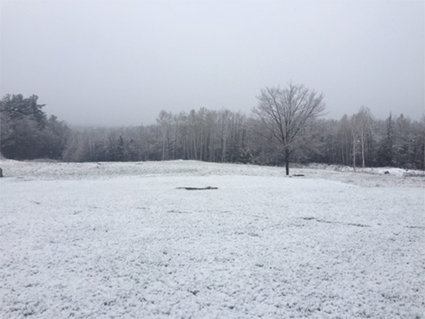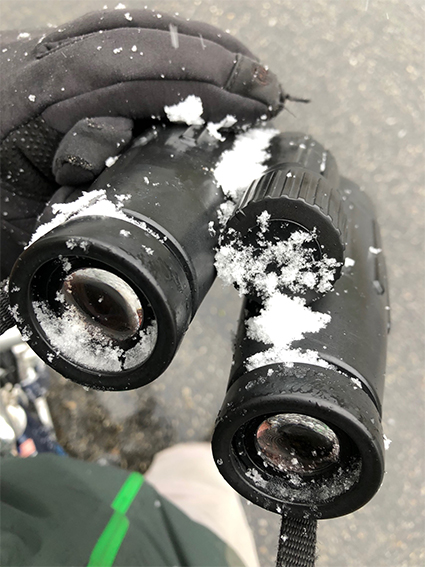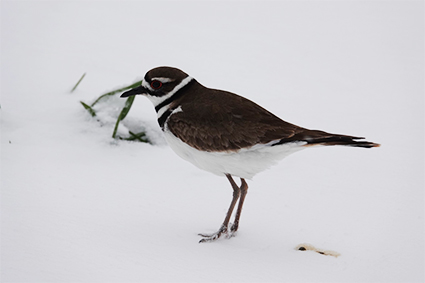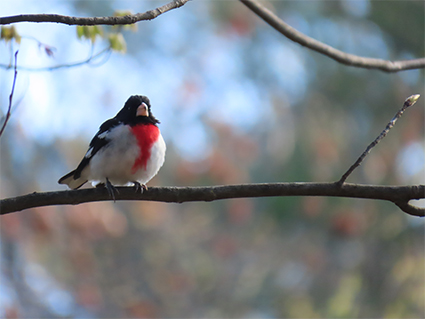A Socially-Distant Christmas-in-May Birdathon 2020

Ken Klapper took this photo of his very snowy yard on May 9, the first day of Birdathon 2020.
Reprinted from the Spring 2020 issue of New Hampshire Bird Records
Compiled by Rebecca Suomala and Kathryn Frieden
NH Audubon’s Birdathon took place on World Migratory Bird Day, May 9, 2020 but expanded to include May 10 thanks to a snowstorm. In keeping with the COVID-19 times, it had a local and socially-distant twist! Pam Hunt, who coordinated the event described it this way:
Birdathon 2020 is a celebration of local birding, whether it occurs in your yard, your town, or within walking range. Instead of teams competing against each other for high species totals and bragging rights, we’re all in this one together. The contest is only against ourselves, and the more people we have the better we’ll do, and perhaps set a bar we can try to overcome in a future year. The goal is simple; how many species we can collectively find within New Hampshire on May 9 [May 10 added].
Participants were restricted to local birding options (not mutually exclusive):
- Your own property, whether a small yard or 20 acre lot
- Your town or perhaps a couple of adjoining towns
- An area within a 5 mile radius of your house (measured as the crow flies!)
- One or more nearby conservation properties
- Human-powered, walking or biking (or paddling if you live on water)
The concept turned out to be very popular with 124 people participating and many sending email comments about the fun they had despite the weather. On Birdathon weekend, May 9 and 10, there were record low temperatures (even the high temperature of 42 degrees F. in Concord on May 9 was the lowest high in 150 years of data collection), up to a foot of snow, and winds gusting almost to 50 miles per hour.
We present excerpts from Pam’s summary and highlights from individuals who took part.
Pam Hunt
The theme of Birdathon 2020 was of course “local birding,” and only a handful actually left their home (or adjacent) town, and at least 55 never even left their yards. We collectively reported 161 species between Saturday and Sunday. Of those, a handful were reported by over 100 participants. As one might expect, these were the common backyard birds like Black-capped Chickadee, Blue Jay, American Robin, and Northern Cardinal. Less common, but still widely reported were many of the colorful migrants that had only just begun to return to New Hampshire for the summer. Having only recently returned from warmer climes, species like Rose-breasted Grosbeaks and Baltimore Orioles were probably caught a little off guard by the cold and snow, and as a result many ended up visiting feeders – much to the enjoyment of many observers. At the other extreme, 26 species were reported only once, with over half of these from Great Bay or the coast. Three species stand out: Horned Lark and Common Gallinule in Concord and a Long-billed Dowitcher in Hampton.
Birdathon is also about people and our enjoyment of birds (no matter the weather!) so I thought it worthwhile to provide some highlights from individual participants. Without a doubt, top honors go to NH Audubon’s Phil Brown for finding 92 species in Hancock on Saturday. Not only did he accomplish this on the worse of the two days, but he also did it entirely on foot and bicycle (he even got a flat tire near the end). The next day, Becky Suomala and Zeke Cornell also found 92 species in Concord, but they had slightly better weather and used a car. A few other folks had good success in car-based local birding, usually restricted to either a town or within a five-mile radius of their homes. Two deserve “runner-up” status for finding at least 80 species: Kurk Dorsey with 85 species in the Durham area and Ken Klapper with 81 in Sandwich.
It’s not surprising that people choosing the ultimate local birding experience – watching in their yards – generally found far fewer species. In such restricted spaces, a lot can vary based on the amount of habitat, size of your yard, weather (have I mentioned the weather?), or simply how long you watch. The average number of species reported from participants’ yards was 18, with most tallies between 10 and 25. Two yards far surpassed this range, however, and it’s no coincidence that both are the homes of highly-accomplished birders with a wide variety of habitat. Don and Lillian Stokes tallied 54 species on their property in Hancock, which conveniently looks out over a large pond, but top honors go to George and Andrea Robbins of Pittsfield. They found a remarkable 71 species in (or over) their six acre property in Pittsfield, which is also blessed with diverse habitats and a wetland.
As of the end of May, we received over $6,000 in donations, thanks to so many who made contributions to this event. Remember though, that Birdathon is not all about the numbers! Participants with far more typical yards related stories of life birds, or species they hadn’t seen for many years and this is what it’s really about. It’s about enjoying the birds we have, where we find them, and retaining the strong connection to birds, and nature in general, that is arguably an important part of staying healthy.
Kurk Dorsey – Durham, 5/9*
The first (and hopefully not annual) Lee/Durham/Newmarket Christmas-in-May Bird Count was highly successful, with just a few cases of frostbite and hardly a polar bear in sight.
A few highlights:
- Gile Road Marsh, Lee: two Common Mergansers
- Old Mill Rd., Lee: Sora, Yellow Warbler in the snow (that has to be a first for me)
- Adam’s Point, Durham: three Common Terns, but who could blame me for entering them as Arctics? 19 Greater Yellowlegs, continuing Common Loon
- Durham Point Rd. pond: two Ring-necked Ducks, Cliff Swallow in with the hordes (not hoards, but that would seem appropriate too) of Tree Swallows
- Long Marsh Rd., Durham: Winter Wren feeding on the ground with two Pine Warblers
- Lamprey River Preserve, Durham: kestrel harassing a Cooper’s Hawk
- Piscassic Greenway/Neal Mill Rd., Newmarket: Veery, Hooded Mergansers, Osprey on the wetland expressing its opinion of my presence
My total count was around 85 species, which was pretty good given that my fingers are too cold to actually count anything right now. But at least the ticks weren’t much of a problem!
Phil Brown – Hancock, 5/9*

A snowy Birdathon, 5-9-20, by Phil Brown.
I conducted my human-powered NH Audubon Birdathon in cold, windy and often, snowy conditions. I biked 13 miles and walked six in search of birds within 2.5 miles of my house, staying completely within the boundaries of Hancock. Considering the fairly miserable birding conditions and it being a delayed migration year for some species, I was quite pleased to find 92 species between 5:00 am and 5:00 pm.
All the pre-dawn birds cooperated in short order, American Bittern, Wilson’s Snipe, American Woodcock, and a Barred Owl, which flew past me on my second hoot as I set foot out my door at around 5:00. As the snow was blowing across the Valley Farm around sunrise, I picked up Eastern Meadowlark and Solitary Sandpiper as I trekked across the field. The dawn chorus was impacted by blowing snow, which also made detectability challenging at times. I warmed up and enjoyed breakfast at home as I watched the feeders (success on hummingbird, although it looked miserable dodging the snowflakes!).
I spent the middle part of the day at Powder Mill Pond and was rewarded with an excellent showing of birds. It was windy, but most of the raptors showed, as did several waterbirds and even some migrant landbirds working a sunny edge that was out of the wind. I met up with Donald and Lillian Stokes and we tracked down a few species of swallows and a surprise Blue-gray Gnatcatcher.
One of the good things about conducting such a small radius human-powered big day is that the distances to bike and hike aren’t vast (much lower mileage than county-wide or town-wide efforts) and this allows you to bird places a bit more thoroughly. Another is that it isn’t much of a problem to walk home when one’s bike tire blows out. Luckily, when this happened to me, I had already birded Powder Mill Pond and had only the home stretch to walk. The walk rewarded me with several new species in the mid-afternoon hours including a Northern Goshawk carrying food that I flushed from the roadside, a couple of unidentified gulls, and the anticipated Red-tailed Hawk, Killdeer, and Rock Pigeon that were hunkered down in a large field.
As I walked home, I reflected on how grateful I was to have had an excellent day of birding, enjoying fine scenery and even some company of friends, the support from many Birdathon donors, and the knowledge that birds are still there, bringing us joy and hope, especially now.
David Govatski – Pondicherry NWR, 5/9*

Killdeer in the snow on 5-9-20 in Whitefield, NH by Dave Govatski during his Birdathon.
Pondicherry National Wildlife Refuge (NWR): Saturday May 9, 2020 was an ideal training day for being in the Aleutians, six inches of fresh snow, winds northwest 10 mph, gusting over 20 mph, temperature 28 degrees F., and visibility that ranged from 300 feet to 1,200 feet in the blowing snow. Even my dog did not want to go with me. I saw no one else at Pondicherry from 0600-1100 and that was a first for a Saturday in May at Pondicherry. None of the other trailheads had any cars either.
Total Time: five hours
Total Distance Walked: six miles in the snow, and it was great, reminded me of a previous life humping a ruck.
I started at Airport Road and walked to Cherry Pond and planned to get there as the snow ended and before the strong winds from the cold front kicked in. I waited about twenty minutes and the snow sort of let up and I could see half way across Cherry Pond. I noted some Tree Swallows and felt bad for any insectivore knowing it was too cold for any insects to be flying around. After this, I went to Moorhen Marsh and added a few species. Then I backtracked to the platform and on to Little Cherry Pond. The winds picked up and the falling snow from the branches dropped visibility to 50 feet at times. I only saw two species at Little Cherry and they were seven Ring-necked Ducks and two Hermit Thrush. I could not see the far side of Little Cherry Pond. I walked back to the car and saw seven Yellow-rumped Warblers, the only warblers of the day.
I then walked the Localizer Road by the Airport and did not add anything new. I saw turkey tracks but did not count them. I only made it part way down the road because it was flooded by the beavers. I then went to Airport Marsh and added a Greater Yellowlegs, Savannah Sparrow, Common Merganser, and a female Northern Harrier.
The combined results:
- 24 Species: Record low Count
- 137 Total Birds: Record low number
- The numbers are actually pretty decent for the adverse weather conditions.
Molly Jacobson – Merrimack, 5/10*
I’m not sure if the birds got the memo that we were all looking for them today! The wind must have had them all hunkered down. I stayed within the Merrimack town limits and visited four places (three are hotspots): Grater Woods, Wildcat Falls, Watson Park, and Horseshoe Pond. The day was entirely devoid of thrushes and wrens, only one vireo, and woodpeckers were surprisingly scarce. Things started pretty slowly, with only 24 species at Grater Woods for a three hour hike (last year at this time I was getting ~45), 26 species at Wildcat Falls, 13 at Watson Park, and finally 26 at Horseshoe Pond, which is average for these three sites despite the weather. There were not nearly as many warblers as I was hoping, seven species total. In all, I had 53 species for the day, most of which came in the late afternoon. Highlights included Prairie Warbler, Spotted Sandpiper, Chimney Swift, and Green Heron(!).
Susan Wrisley – Hollis, 5/10*
All in all, I had a great Birdathon day, but cold morning temps and high winds made things more challenging. I opted for 5-mile radius birding, but most of my stops were in Hollis, or just across the town line into Nashua and Amherst. My circle extends into Massachusetts, but I stayed in New Hampshire.
Stop #1 (5:00am) – Home: I started my day at home where I picked up both Louisiana and Northern Waterthrush, Ovenbird, Black-and-white Warbler, and Pine Warbler.
Stop #2 (7:15) – Beaver Brook Great Meadow, Hollis: My plan was to arrive before the winds picked up too much and, although I succeeded, I still didn’t see/hear the American Bittern I’d been hoping for. Common Yellowthroats that were non-existent a couple days earlier, were abundant today, but Eastern Kingbirds must have decided to take the day off. Notable additions to my list were a drumming Ruffed Grouse, Warbling Vireo and an Osprey, which saved me a trip to another spot. I spent too much time there waiting for grackles to turn into bitterns and before I knew it the wind had picked up considerably.
Stop #3 (9:35) – Lovewell Pond, Nashua: I had two targets at Lovewell Pond, Green Heron and Virginia Rail. The pond was devoid of Green Herons, but the marsh down the path was generous with four Virginia Rails. I planned to walk Yudicky Farm afterward to see if I could find a Nashville, Blue-winged or any other Warbler, but the place was infested with a swarm of mountain bikers, who seemed hell bent on running over anyone foolish enough to get in their way.
Stop #4 (1:17pm) – Hollis-Brookline High School: I didn’t think the high school would add anything unique to my list, so it wasn’t part of my original plan, but after skipping Yuddicky, I decided to take a look. It turns out the Green Heron I didn’t find at Lovewell Pond was waiting for me at the high school, along with Yellow Warblers and Mockingbirds.
Stop #5 (2:45) – Woodmont Orchard: Woodmont was a blast, but not the “fun” kind of blast. More like a jet engine blast. The wind was so strong it literally almost blew me over. I still managed to pick up a kestrel, clinging to its perch for dear life, and a few pipits and Savannah Sparrows as they blew past me.
Stop #6 (4:15) – Hayden’s Reservoir/Federal Hill Rd.: My targets here were the ever present Yellow-bellied Sapsuckers and Winter Wren…except neither was there. I walked my usual route, not finding much to add to the day’s tally, then returned to my starting point and found the sapsucker and Winter Wren in their usual spots. A Pileated Woodpecker also joined the party, as did a pair of Wood Ducks.
Stop #7 (7:00) – Beaver Brook Great Meadow (again): It was getting late, but the wind was finally calming down and I had just enough time to get back over to Great Meadow to try again for the American Bittern. I hadn’t even made it all the way to the marsh before I started hearing the classic kerplunk! Success! A Northern Rough-winged Swallow was a nice bonus, but still no Eastern Kingbird or Blue-gray Gnatcatcher.
Stop #8 (8:00) Dinner Break – Home: My often reliable Barred Owl spot had been a bust earlier in the day, so when I arrived home at 8:00 pm, I decided to stop at the end of my long driveway and try just one Barred Owl call. No sooner had I finished than a large bird came right down the driveway, flying straight at me! As the owl sailed directly over my head, I looked up at it and thought “please don’t poop on me.” I also thought it was an incredibly amazing experience…especially since I didn’t get pooped on.
Stop #9 (9:15) – Howe Drive, Nashua: At 9:00 pm I set off for the final stop of the day, just over the Hollis line into Amherst. The moon hadn’t risen yet, but I figured I’d try for whip-poor-wills and woodcocks anyway. An early-bird whip-poor-will was happily singing, but not a single peent was heard.
Rebecca Suomala – Concord, 5/10

Rebecca Suomala photographed this White-crowned Sparrow feeding on scattered seed during snow showers on the first day of the Birdathon, 5-9-20.
A few of us decided to convert our Birdathon into a May “Concord Challenge,” spending the entire day in Concord, NH. We wanted to see how many species we could find in a single day (something we do annually in November with Pam Hunt) while also contributing to the statewide Birdathon total.
Zeke Cornell and I were ready to go on Saturday, May 9, but it was snowing in the morning so I opted to just scatter some bird seed in my yard and wait for Sunday. Check out the video: https://youtu.be/6CPJu37yP_g.
On May 10, the skies were clear and we were ready to go. We started at 4:45 am with an Eastern Whip-poor-will and ended 16 hours later with a displaying American Woodcock. Although it wasn’t snowing, it was only 38 degrees at sunrise, but that didn’t stop an American Bittern and four Virginia Rails from calling.
We had no rarities, but a Greater Yellowlegs was another nice highlight. Although the sun was out, the cold and windy conditions were challenging, combined with the late spring migration this year. In the end, we were excited to tally 92 species just in the town of Concord.

See a video of the Birdathon day here: https://youtu.be/4VqiRzbXnD4. Video and Rose-breasted Grosbeak photo by Rebecca Suomala.
* excerpted from posts to the NHBirds email list.